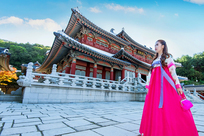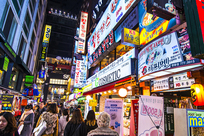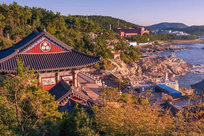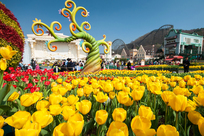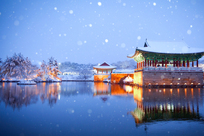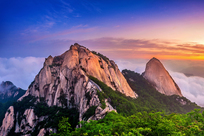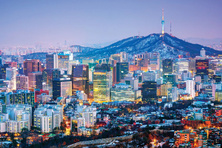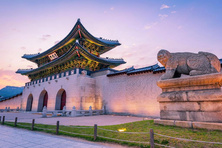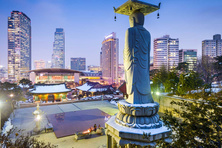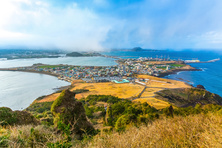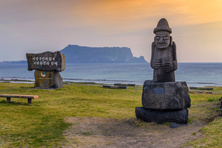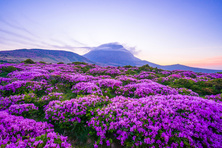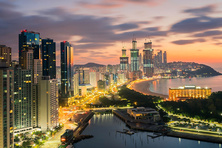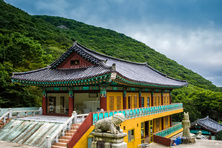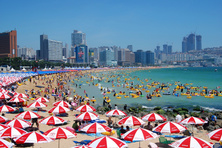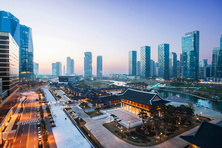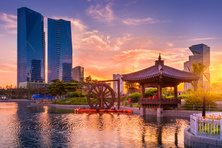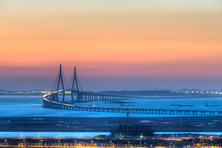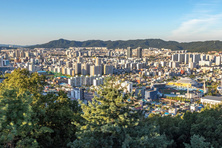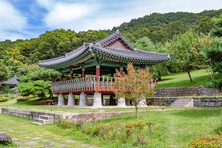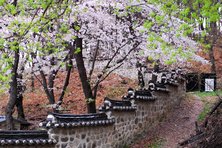South Korea
- Capital:Seoul
- Currency: South Korean won
- Time: UTC+9
- Languages: Korean
- Religions: Buddhism, Christianity
- Sections: Get in Visa Customs Cuisine Money Details of interest Popular resorts
The South Korea or officially the Republic of Korea is a state in East Asia partly covering the Korean Peninsula. The country borders North Korea. The west of the country is washed by the waters of the Yellow Sea and south and south-east of the country are washed by the Korea Strait. On the east, South Korea is washed by the Sea of Japan. The capital city is Seoul.
The climate in South Korea is monsoon temperate. The average temperature in summer is +21°C - +24°C. In winter, the temperature can be as low as -10°C at the coast and -20 in the central parts of the country. The best time for visiting South Korea is from June to October.
The official language is Korean. The majority of the population are the Buddhists and the Christians. However, these two religions are under a great influence of Shamanism and Confucianism.
For skiing, go to the suburbs of Seoul, to such resorts as Muju and Suanbo, Enphen in Gangwon-do, Phoenix Park, bears Town in Pocheon, and Jisan Forest Ski resort in Icheon. In the Korean Alps, there is everything for skiing and snowboarding.
The Hanwha Resort Seorak in the Kangwon Province, the Yuseong Foot Spa in Daejeon in the South Jeolla Province are the main destination for the wellness tourism. Near the city of Busan, the tourists will find the Dongnae Hot Spring Zone. The tourists who want to improve their health will like the thermal complexes in the city of Icheon.
If you like beach holidays, head to the Jeju island and to the suburbs of the port city Busan.
One will get an unforgettable diving experience in Seogwipo and on the Jeju island where snorkeling is also popular. Surfers and windsurfers usually gather in Busan, on the Jeju island and in the south east part of the Old City in Seoul.
Those who prefer country holidays, should take a trip to Seoraksan Mount, to Gyeongju, Busan and to the cradle of Confucianism Andong. Anyone can go to the aqua parks Seorak Waterpia, Caribbean Bay water park, Woongjin Playdoci и Icheon Termeden.
Stay longer in Seoul, Busan, Ulsan and Icheon if you crave for city entertainments and shopping.
Get in
By Plane
The tourists from Moscow and other CIS countries can take direct flights offered by Korean Air and Aeroflot. Vladivostok Avia offers flights to Busan and Seoul from Vladivostok and Asian Airlines offers flights from Yuzhno-Sakhalinsk, and Khabarovsk.
KLM, Finnair, Czech Airlines, and Lufthansa offer transit flights with a stop in some European and Asian hub airports.
By Ferry
There is a regular ferry route between Vladivostok, Dongnae, and Sokcho. The tourists from China, North Korea, and Japan can get to South Korea by ferry.
Visa
The travelers from EU countries do need a visa to get to South Korea.
The citizens of CIS countries can travel to South Korea visa-free provided that their stay in the country will not exceed 60 days. Every 180 days, the citizens from CIS countries have a right to stay in the Republic for 90 days.
The documents for a visa can be submitted personally or via the service Pony Express.
A long-term visa is valid for 91 days and the time for processing the documents for the visa is from 10 days to 4 weeks.
Customs
The tourists can import foreign currency without any restrictions but the sums over 10.000 US dollars must be declared. If the currency exceeding this limit is not stated in the declaration form, it will be confiscated at the border. Keep the declaration form until the end of your trip. Import and export of national currency is limited at 8.000.000 KRW.
The tourists older 19 years old can bring the following goods duty-free:
- alcohol and tobacco;
- up to 67 ml of perfume;
- souvenirs and gifts the sum of which does not exceed 400.000 KWR.
It is prohibited to import:
- audio and video materials from Communist countries;
- fresh fruits and walnuts;
- plants in soil, seeds and seedlings of fruit plants.
It is not allowed to export antiques, archaeological findings and precious metals (without a permit).
Cuisine
The South Korean cuisine is based on fresh vegetables, rice and fish. Many dishes may seem a bit too hot for the tourists.
Rice is the main ingredient for almost all South Korean dishes. In this country, you will have a chance to try traditional rice flour rolls Tteok, traditional pilaf Bibimbap, and a rice sandwich with omelet Kimpap. These dishes are usually served with Panchhan, favourite Korean appetizer Kimchi, jelly Dotorimuk and soy cottage cheese Tubu.
We recommend trying Korean beef and pork dishes. The most favorite delicacy in South Korea is Bulgogi (small beef kebabs) and Galbi (roast pork or beef ribs). Kalbi Chim (stewed pork ribs), Dak Galbi (chicken, sweet potatoes, seaweed and rice casserole) and Mandu (Korean dumplings) also gained popularity.
It is difficult to imagine the Korean cuisine without seafood and fish. The foodies can treat themselves to sea shells, crabs, squads, sea cucumbers and very delicious seaweed soups. Discover an unusual taste of Hoe (chopped raw fish), Jangeo gui (fried fish with seaweed), Haemul Chon-gol (seafood stew), Chueotang (hot mudfish soup), Oktomgui (broiled fish) and flatbread Pajeon with seafood and sea shells with grapefruit sauce.
Soups hold a very important place in the South Korean diet. Try Galbitang (beef broth with ribs), Soondubu Jjigae (sea shell and soy soup), hot soup Haemul tang with seafood, meat soup Luotal and seaweed soup Miyeok guk. There is an ancient Korean tradition that a birthday person should eat a portion of Miyeok guk and then luck will be with him or her the whole year.
For a dessert, try sugared fruits and walnut cookies Hodugwaja. This dessert should be served with ginseng tea Insam Cha or peanut tea with rice cakes. If you crave for new flavors, you will like ginseng tea Saenggang cha and Yujacha (citrus syrup).
Traditional beverages in South Korea are rice wine Nonju and Makgeolli and rice alcoholic drink Soju, a source of pride of the Koreans.
Money
The official currency of South Korea is won (KRW). The National bank of South Korea issues bank notes (1.000 — 5.000 won) and coins.
We recommend exchanging currency at banks, in large hotels and exchange offices. You will not have any problems in finding ATMs in South Korea.
On the markets and in small shops, the tourists can pay with US dollars.
The credit cards Diners Club, American Express, MasterCard, VISA and JCB are accepted in all restaurants, hotels, large malls, banks and by ATMs. The travelers can cash traveler’s checks in international travel agencies, shipping companies and at banks. Traveler’s checks with a nominal value 100.000 KRW can be cashed only if you have a temporary residence permit in South Korea.
The Tax-Free system is available in South Korea. To refund VAT, the tourists should make a purchase for 30.000 KRW during one day and receive the Tax-Free Shopping Cheque. When leaving the country, the tourists should show this cheque and the goods in the original package. You can get the refund right there or the money can be transferred to your bank card.
Details of interest
Sightseeing in South Korea
- The hallmark of Seoul is the four royal palaces of the Joseon Dynasty, the oldest Gyeongbokgung Palace, the Deoksugung Palace, Jeongdong Theater, Chosun Ilbo Art Gallery and the ancient Anglican Church. In the South Korean capital, the tourists can see the Banpo Moonlight Rainbow Fountain. The Gyeonghui Palace is of a great tourist interest because every morning anyone can see the opening of the oldest ceremonial Namdaemun Gate. The tourists can take an excursion to the magnificent Changgyeong Palace and Changdeokgung Palace. The Jongmyo Shrine, the Royal Tombs of the Joseon Dynasty and the Changdeokgung Palace Complex are under UNESCO protection. You will be amazed by the Yuksam Building skyscraper and the Museum of optical illusions.
- Your trip to the Hwaseong Fortress will be an unforgettable experience. The fortress is a UNESCO site. It is built near the city of Suwon in the Gyeonggi Province. In the city of Yongin, the tourists can visit the Everland Park, the museum park Namsangol Hanok Village, and the Namhansanseong Castle which is a UNESCO site.
- The Seoraksan National Park which includes many mountain peaks and is situated on the Sea of Japan coast is believed to be most picturesque place in the country.
- We also recommend visiting Busan and see the Endusan Park and Taejongdae Park, the area Nampo-dong and the United Nations Memorial Cemetery. In the suburbs of the city, there are Tongdosa temples, Beomeosa Temple, and Donghae Bath House.
South Korean Souvenirs
- Korean embroidery (pictures and table cloth), and textile umbrellas are sold in Icheon.
- Green tea, jojoba and ginseng tea are sold in Suwon.
- Go to Seoul to buy onyx, amethyst, jade and gold jewelry, office equipment, and gadgets.
- Pottery, porcelain dolls and figurines, leather goods (wallets and bags) can be bought in Busan.







